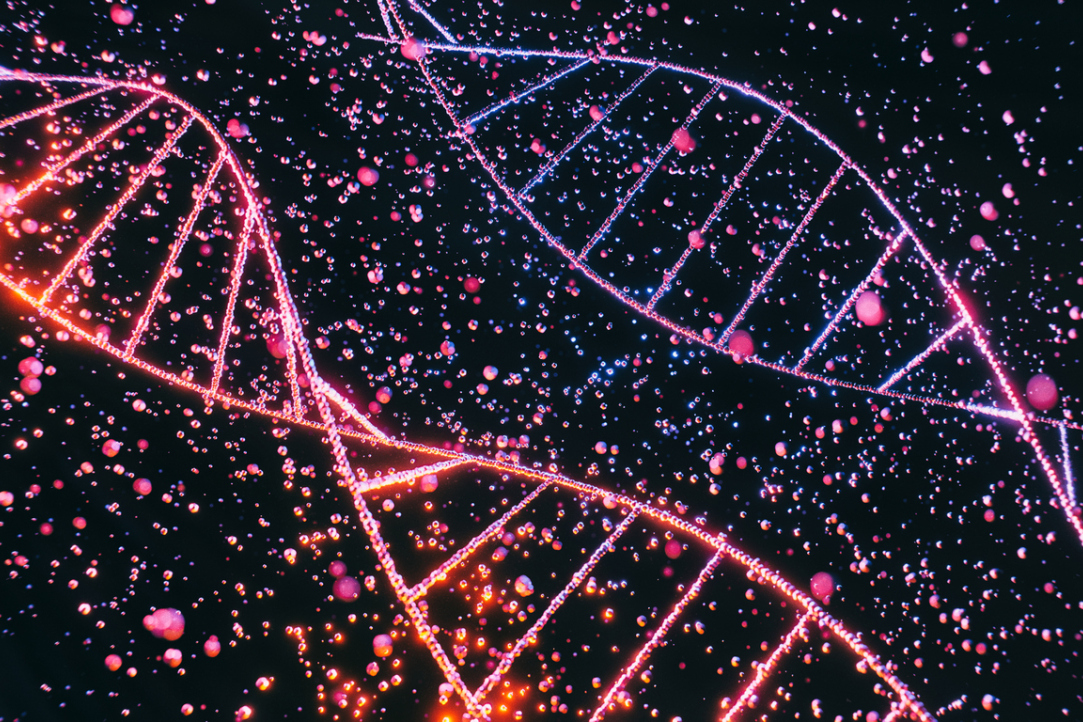Scientists Propose Novel Theory on Origin of Genetic Code

Alan Herbert, Scientific Supervisor of the HSE International Laboratory of Bioinformatics, has put forward a new explanation for one of biology's enduring mysteries—the origin of the genetic code. According to his publication in Biology Letters, the contemporary genetic code may have originated from self-organising molecular complexes known as ‘tinkers.’ The author presents this novel hypothesis based on an analysis of secondary DNA structures using the AlphaFold 3 neural network.
The genetic code is the 'alphabet' that underpins the functioning of all living systems on Earth. It dictates the content of an organism's 'instructions' and how they should be interpreted. The contemporary genetic code is composed of codons, each consisting of three nucleotides. These triplets encode amino acids, which are then involved in protein synthesis. Scientists have been studying the genetic code for over 70 years, yet one of the most important questions—how it originated—remains unanswered.
Professor Alan Herbert, Scientific Supervisor at the HSE International Laboratory of Bioinformatics, has put forward a new explanation for the origin of the genetic code. In his view, during evolution, flipons—DNA sequences capable of forming secondary structures—played a key role in the development of the contemporary genetic code.
The classical DNA molecule, as described by Francis Crick and James Watson, is a double helix that twists to the right. However, scientists have discovered alternative DNA structures, including Z-DNA, which twists to the left, as well as three-stranded and four-stranded sequences, and knot-like DNA structures known as i-motifs. These unusual structures arise under specific physiological conditions, and their type depends on the sequence and arrangement of nucleotides within the flipon itself. The simplest flipons are formed from repeating nucleotide sequences, leading to the assumption that such sequences were abundant in the so-called primordial soup.

Maria Poptsova
Using DeepMind's AlphaFold 3 neural network, Alan Herbert analysed the nature of the bonds between flipons and amino acids. 'It turns out that flipons formed from two-nucleotide repeats bind very effectively to simple peptides composed of two-amino acid repeats. It is precisely this correspondence that exists in the contemporary genetic code,' comments Maria Poptsova, Head of the HSE International Laboratory of Bioinformatics.
For example, the cytosine-guanine repeat CGCGCG forms Z-DNA, and the peptide with the arginine-alanine repeat RARARA binds effectively to this sequence. In the contemporary genetic code, the CGC codon corresponds to arginine, while the GCG codon corresponds to alanine. A detailed analysis of spatial interactions reveals that the strongest connection occurs between non-overlapping triplets: CGCGCG binds to RA.
In his publication, Alan Herbert examines numerous examples of the interaction between flipons formed from short repeats and peptides made up of amino acid repeats. It has been found that reactions leading to mutual chain elongation can also occur, especially in the presence of magnesium and zinc, which act as catalysts.
According to the study author, such complexes were once formed by special components—tinkers, as François Jacob called them. In Professor Herbert's work, structures composed of flipons and peptides serve as self-replicating tinkers. Tinkers used DNA as a template for protein synthesis, while proteins, in turn, facilitated the elongation of the DNA helix. As a result, a non-overlapping triplet code emerged: the odd number of bases enables the encoding of sequences from different amino acids, while the nature of bonds between flipons and amino acids dictates that each codon corresponds to only one amino acid.
'The role of flipons as tinkers in the early stages of biological evolution offers a radically new perspective on the origins of life. It is no exaggeration to say that if this theory is experimentally confirmed, our colleague Dr Herbert deserves the Nobel Prize,' explains Poptsova. 'The discovery of interactions between flipons and amino acids, in accordance with the contemporary genetic code table, proves that the emergence of the genetic code is not an accident but a natural outcome of evolution. Nature does not create anything from scratch; it develops new mechanisms using what is already available. Nature acts like a tinkerer who, when needing to quickly create something functional—but not necessarily reliable or durable—grabs whatever is at hand.'

Alan Herbert
'Overall, the proposed scheme does not require a DNA, RNA, or peptide world to explain life’s origins,' writes Alan Herbert in his article. 'Instead, the tinkers described are agents that promote this eventuality. They arise from the simple match between low-complexity nucleotide and simple peptide polymers, using metals to catalyse their initial replication. By spiking the prebiotic soup with copies of themselves, these tinkers quite naturally evolved a non-overlapping, triplet genetic code.'
In addition to advancing our understanding of life's origins, studying tinkers could lead to the development of new technologies, including artificial self-organising systems and self-healing materials. The tinkers’ ability to combine various chemical elements can be used for directed evolution of new biomolecules.
See also:
Scientists Test Asymmetry Between Matter and Antimatter
An international team, including scientists from HSE University, has collected and analysed data from dozens of experiments on charm mixing—the process in which an unstable charm meson oscillates between its particle and antiparticle states. These oscillations were observed only four times per thousand decays, fully consistent with the predictions of the Standard Model. This indicates that no signs of new physics have yet been detected in these processes, and if unknown particles do exist, they are likely too heavy to be observed with current equipment. The paper has been published in Physical Review D.
HSE Scientists Reveal What Drives Public Trust in Science
Researchers at HSE ISSEK have analysed the level of trust in scientific knowledge in Russian society and the factors shaping attitudes and perceptions. It was found that trust in science depends more on everyday experience, social expectations, and the perceived promises of science than on objective knowledge. The article has been published in Universe of Russia.
Scientists Uncover Why Consumers Are Reluctant to Pay for Sugar-Free Products
Researchers at the HSE Institute for Cognitive Neuroscience have investigated how 'sugar-free' labelling affects consumers’ willingness to pay for such products. It was found that the label has little impact on the products’ appeal due to a trade-off between sweetness and healthiness: on the one hand, the label can deter consumers by implying an inferior taste, while on the other, it signals potential health benefits. The study findings have been published in Frontiers in Nutrition.
HSE Psycholinguists Launch Digital Tool to Spot Dyslexia in Children
Specialists from HSE University's Centre for Language and Brain have introduced LexiMetr, a new digital tool for diagnosing dyslexia in primary school students. This is the first standardised application in Russia that enables fast and reliable assessment of children’s reading skills to identify dyslexia or the risk of developing it. The application is available on the RuStore platform and runs on Android tablets.
Physicists Propose New Mechanism to Enhance Superconductivity with 'Quantum Glue'
A team of researchers, including scientists from HSE MIEM, has demonstrated that defects in a material can enhance, rather than hinder, superconductivity. This occurs through interaction between defective and cleaner regions, which creates a 'quantum glue'—a uniform component that binds distinct superconducting regions into a single network. Calculations confirm that this mechanism could aid in developing superconductors that operate at higher temperatures. The study has been published in Communications Physics.
Neural Network Trained to Predict Crises in Russian Stock Market
Economists from HSE University have developed a neural network model that can predict the onset of a short-term stock market crisis with over 83% accuracy, one day in advance. The model performs well even on complex, imbalanced data and incorporates not only economic indicators but also investor sentiment. The paper by Tamara Teplova, Maksim Fayzulin, and Aleksei Kurkin from the Centre for Financial Research and Data Analytics at the HSE Faculty of Economic Sciences has been published in Socio-Economic Planning Sciences.
Larger Groups of Students Use AI More Effectively in Learning
Researchers at the Institute of Education and the Faculty of Economic Sciences at HSE University have studied what factors determine the success of student group projects when they are completed with the help of artificial intelligence (AI). Their findings suggest that, in addition to the knowledge level of the team members, the size of the group also plays a significant role—the larger it is, the more efficient the process becomes. The study was published in Innovations in Education and Teaching International.
New Models for Studying Diseases: From Petri Dishes to Organs-on-a-Chip
Biologists from HSE University, in collaboration with researchers from the Kulakov National Medical Research Centre for Obstetrics, Gynecology, and Perinatology, have used advanced microfluidic technologies to study preeclampsia—one of the most dangerous pregnancy complications, posing serious risks to the life and health of both mother and child. In a paper published in BioChip Journal, the researchers review modern cellular models—including advanced placenta-on-a-chip technologies—that offer deeper insights into the mechanisms of the disorder and support the development of effective treatments.
Cardiogenetics of the Future: Sequencing Helps Treat Heart Disease
Future cardiologists, geneticists, and IT specialists gathered at HSE University to learn how to 'read' DNA for diagnosing cardiovascular diseases. They explored modern sequencing methods and the complexities of working with digital twins of cardiac patients.
Using Two Cryptocurrencies Enhances Volatility Forecasting
Researchers from the HSE Faculty of Economic Sciences have found that Bitcoin price volatility can be effectively predicted using Ethereum, the second-most popular cryptocurrency. Incorporating Ethereum into a predictive model reduces the forecast error to 23%, outperforming neural networks and other complex algorithms. The article has been published in Applied Econometrics.


